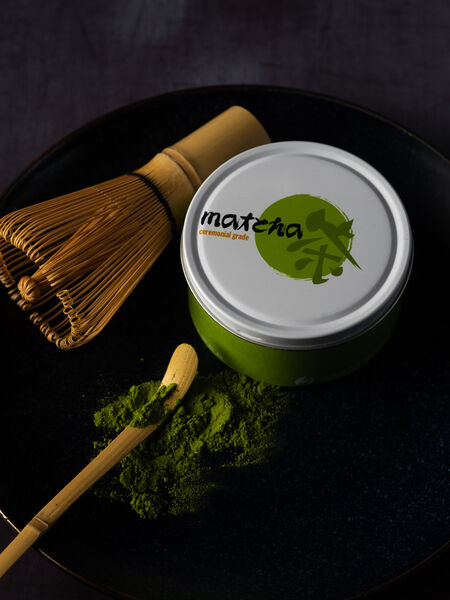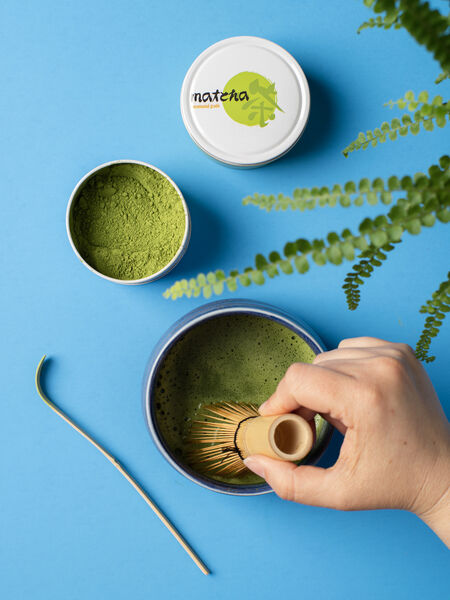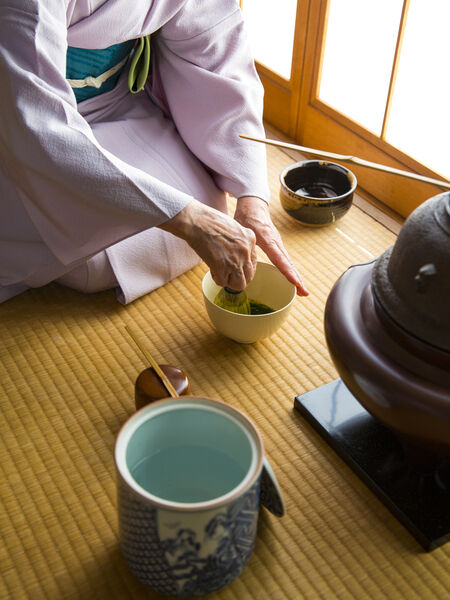Matcha



In the exquisite tea ritual of Japan, chanoyu, the host prepares a singular tea, one that is a brilliant kelly green, powdered, mixed with hot water and whisked to a frothy brew. The labor to create this tea is intense and the many steps are involved. While there are certainly many imitations and quality range is wide, the finest matcha comes from the finest gyokuro, the buttery sweet green tea of Japan.
How Does Gyokuro Become Matcha?
In mid-April, the tea plants receive conscientious, tender, care including being shaded with bamboo reed mats or tarps, gradually reducing the amount of sunlight allowed to reach the bushes. This is done for up to two months to help increase the levels and intensity of color and flavor of the very element that makes the gyokuro a deep hunter green: chlorophyll. Some growers add increasing amounts of cover, from reed screens to rice straw, to reduce available sunlight, and some growers shade leaves once more, up to one month or longer.The plucking begins, usually on hachijuhachiya, the 88th day after the first day of spring (risshun), which varies slightly from year to year, but always arrives in early May. The tea leaves are all picked by hand. These harvested leaves are not rolled or shaped like other green tea leaves but steamed to prevent immediate oxidation and to ensure that they retain their green color. Steaming varies from processor to processor but is usually a mere 20 seconds or slightly longer. This step is always done within 20 hours of plucking.
Usually, the leaves are then gently air dried by hand-tossing them, or in some areas, dried in a brick oven, to completely remove the moisture. What remains is called tencha. It is stored in large wooden boxes and refrigerated and processed as needed. To prepare these leaves to be matcha, the dried leaves are first graded and cleaned. All the stems, twigs and even the veins of the leaves are removed (usually by machines). When the leaves are even in size and in color. It is only then that the tencha is ready to segue into its final product, matcha.
Tencha is stone ground into the micro-powder consistency of talcum powder. Stone grinding has been the key to fine matcha for more than eight centuries. Some manufacturers still use hand operated stone mills to manually grind the tencha; others use an automated stone mill. Both methods will provide a matcha that has a very fine texture and brilliant green color. The finest of these are used for traditional tea drinking; Ingredient or Café Grade matcha is made from lesser-quality leaves and it is ground less finely because it is used for matcha drinks like lattes (where the delicacy of finer grades would be overwhelmed by the addition milk to the beverage).
What's in Matcha?
Matcha contains a relatively high stimulant content compared to other teas which gives us a refreshing energetic lift. This is also why a lot of people enjoy matcha in lieu of coffee first thing in the morning. Like all stimulants in Camellia sinensis, they are absorbed slower into the body and, in general, produce alertness and energy rather than the jitters. Although delicious, the general recommendation is one or two small (two or three-ounce) cups of matcha per day. As always, remember that stimulants impact individuals differently. Because the total leaf is consumed, higher levels of catechins and vitamins are also consumed so matcha has slightly higher levels of all that is good in green tea, especially the amino acid, L-theanine which not only provides alertness, it is the primary element that gives matcha its unique taste.Part of the uniqueness of matcha is that it includes the entire leaf. For all other tea, no matter where it is grow and no matter how it is processed, one infuses tea leaves in water, discards the leaves and drinks only the tea-flavored water. In matcha, we drink leaf and water because it is brewed from a dried, powdered full leaf; we discard nothing. This, more than anything else, is why the flavor and the naturally-occurring elements are more intense and more healthful.
How to Prepare Matcha
Heat the water for the tea, up to 180 degrees, using some to warm the matcha bowl and the remainder for the brewing. Care should be taken to measure both tea and water at first until you feel comfortable enough to add or lower the amounts according to your taste. To begin, warm the tea bowl with hot water, then place the whisk in it to dampen the prongs only. Remove the whisk and shake off excess water, then place it upright. Discard the water from the bowl and wipe it dry with your tea cloth.
Measure one teaspoon of the tea and place it into the bowl, add three ounces and whisk briskly, using a zigzag motion until the brew froths. (Think of making the letter W over and over again.) Use your wrist, not your full arm to whisk.
Drink immediately, in three generous sips. These directions are for usucha, thin matcha; anyone new to this beverage may actually like it even "thinner". If so, use up to six ounces of water; this provides a more delicate, less intensely green taste. Using three ounces of water to one teaspoon of tea will provide an intense more typical matcha taste in the usucha style. Once you have the tea preparation down you can then experiment with tea and water quantity to your taste.
Usucha tea is matcha from leaves of a tea plant younger than thirty years old. Koicha matcha is made from older trees and has a more mellow, sweeter taste. It is thicker because it uses more more matcha powder- usually about four times as much! Therefore, it is considered "thick" tea compared to usucha or "thin" tea. Thick matcha, koicha, is also made slightly differently, without froth, and has several other more essential steps to its preparation.
In chanoyu, it is customary to sift the matcha just before using. This allows the tea to dissolve more completely during the whisking because any possible lumps are removed. To sift, place a mesh strainer over a small caddy, place the measured matcha in the sifter and tap the side of the sifter until the sifted matcha falls to the bottom of the bowl.
You can also sift the powdered tea onto a piece of 8" x 11" white paper. Fold it in half. Open it up and lay it flat, crease edge on the table. Sift the tea as much into the interior crease as possible. Fold the edges of the paper together and the crease will become a neat funnel you can use to pour the matcha into your tea caddy. You are now ready to scoop out what you need and proceed. This is particularly useful when serving more than two people a cup of matcha.
Matcha lattes can be made hot or cold. If making hot, heat the milk to under boiling when just a few tiny bubbles appear. Add six ounces of milk to one teaspoon matcha. Because lower grades are used, more casual frothing can be done by using your bamboo whisk, a blender or simply shake vigorously in a covered jar. Pour into a glass or cup and serve immediately.
Some traditionalists insist on refrigerating matcha, but in general, placing it into a dark, cool and dry place will be fine. Matcha's brilliant green color indicates its aliveness and freshness; when it turns darker, the color of green olives, it has begun to age and will not provide good flavor in the cup. Buy in small amounts and drink promptly (within two to four weeks). If you choose to refrigerate matcha, scoop out what you need into a caddy or bowl to bring it to room temperature, close the container and return it immediately to the refrigerator.
Do I need all the traditional tools? No, however, for the best flavor and consistency in the brew, an inexpensive bamboo whisk is essential. A bamboo spoon/scoop is preferably to a metal or plastic measuring spoon, but you can put that on your wish list at first! Like a teaspoon, the other tools for matcha preparation are probably already in your kitchen. The following are the traditional chanoyu utensils and their Japanese names:
-Ceramic matcha bowl (chawan)
-Bamboo whisk (chasen)
-Long stemmed bamboo matcha spoon (chashaku)
-Linen or cotton tea cloth (chakin)
-Matcha sifter (furui)
-Small glass or porcelain pitcher for the water
-Thermometer to test water temperature unless you have a temperature controlled tea kettle
-Small lacquerware, ceramic or glass caddy for tea (for presentation only; always store the tea in its original container)
These items are modestly priced and, again, it is essential that only bamboo utensils should be used because they will not interfere with the delicacy of matcha tea. If you have a limited budget, use it to buy a high-quality bamboo whisk first. Whisks come with 50-120 prongs for thin matcha and 32 to 48 prongs for thick tea, so choose whisks with the greater number for at-home use. Using metal scoops or wire whisks can contaminate the flavor and spoil your tea-drinking experience. Use a ceramic or porcelain bowl, too, not metal or plastic for the same reason.
Japanese sifters are now made with stainless steel, work wondrously yet are quite pricy. Consider them as an option for an accoutrement that can last a lifetime. Until then, consider a screen-like sieve. For the brief time that the matcha is in contact with a wire mesh sieve, it is assumed that this will not impact flavor much. Certainly, a very fine wire mesh is preferred over plastic. In either case, since the mesh will not be in contact with hot water, it is much less likely to contaminate the flavor of the tea.
 teaclass
teaclass
